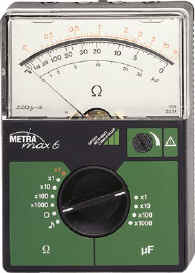Ohmmeter
Ohmmeter is an electronic instrument used for measuring the electrical resistance of a component or device. The unit of measurement is ohms, symbolized by the Greek letter omega (Ω). Ohmmeters are essential tools in the field of electronics and electrical engineering, enabling technicians and engineers to assess the functionality of circuits and components.
History[edit | edit source]
The concept of measuring resistance has been integral to the development of electrical and electronic theory and practice. The ohmmeter, as a specialized tool, evolved from the early galvanometers and voltmeters, with significant advancements occurring in the 20th century as electronics became more sophisticated.
Types of Ohmmeters[edit | edit source]
There are several types of ohmmeters, each designed for specific applications and levels of measurement precision:
- Series Ohmmeter: The most basic form, which incorporates a simple series circuit with a battery, a variable resistor, and a meter. It is primarily used for quick checks and is known for its simplicity.
- Shunt Ohmmeter: Uses a parallel circuit configuration. It is more complex and can provide more accurate measurements than the series type.
- Digital Ohmmeter: Offers high precision and the ability to measure a wide range of resistance values. Digital ohmmeters are the most commonly used type today, featuring digital displays that show resistance values directly.
- Megohmmeter: Also known as a "Megger," this type is used to measure very high resistance values, typically in the megohms range. It is particularly useful for testing insulation in electrical wiring and components.
Operation[edit | edit source]
The operation of an ohmmeter involves creating a closed circuit between the ohmmeter and the component being tested. The ohmmeter applies a small voltage through its internal battery to generate a current. The resistance is then calculated based on the voltage applied and the current that flows, using Ohm's Law (V = IR), where V is voltage, I is current, and R is resistance.
Applications[edit | edit source]
Ohmmeters are used in a variety of settings, from simple home electronics projects to complex industrial systems. Their applications include:
- Testing and troubleshooting electrical circuits and components.
- Quality control in manufacturing processes.
- Maintenance of electrical systems in automotive, aviation, and marine industries.
- Inspection of electrical installations and safety checks.
Safety Considerations[edit | edit source]
When using an ohmmeter, it is crucial to ensure that the component or circuit being tested is disconnected from any power source to prevent damage to the ohmmeter and ensure accurate measurements. Additionally, observing proper safety protocols when working with electrical systems is essential to prevent accidents.
See Also[edit | edit source]
Search WikiMD
Ad.Tired of being Overweight? Try W8MD's physician weight loss program.
Semaglutide (Ozempic / Wegovy and Tirzepatide (Mounjaro / Zepbound) available.
Advertise on WikiMD
|
WikiMD's Wellness Encyclopedia |
| Let Food Be Thy Medicine Medicine Thy Food - Hippocrates |
Translate this page: - East Asian
中文,
日本,
한국어,
South Asian
हिन्दी,
தமிழ்,
తెలుగు,
Urdu,
ಕನ್ನಡ,
Southeast Asian
Indonesian,
Vietnamese,
Thai,
မြန်မာဘာသာ,
বাংলা
European
español,
Deutsch,
français,
Greek,
português do Brasil,
polski,
română,
русский,
Nederlands,
norsk,
svenska,
suomi,
Italian
Middle Eastern & African
عربى,
Turkish,
Persian,
Hebrew,
Afrikaans,
isiZulu,
Kiswahili,
Other
Bulgarian,
Hungarian,
Czech,
Swedish,
മലയാളം,
मराठी,
ਪੰਜਾਬੀ,
ગુજરાતી,
Portuguese,
Ukrainian
Medical Disclaimer: WikiMD is not a substitute for professional medical advice. The information on WikiMD is provided as an information resource only, may be incorrect, outdated or misleading, and is not to be used or relied on for any diagnostic or treatment purposes. Please consult your health care provider before making any healthcare decisions or for guidance about a specific medical condition. WikiMD expressly disclaims responsibility, and shall have no liability, for any damages, loss, injury, or liability whatsoever suffered as a result of your reliance on the information contained in this site. By visiting this site you agree to the foregoing terms and conditions, which may from time to time be changed or supplemented by WikiMD. If you do not agree to the foregoing terms and conditions, you should not enter or use this site. See full disclaimer.
Credits:Most images are courtesy of Wikimedia commons, and templates, categories Wikipedia, licensed under CC BY SA or similar.
Contributors: Prab R. Tumpati, MD

